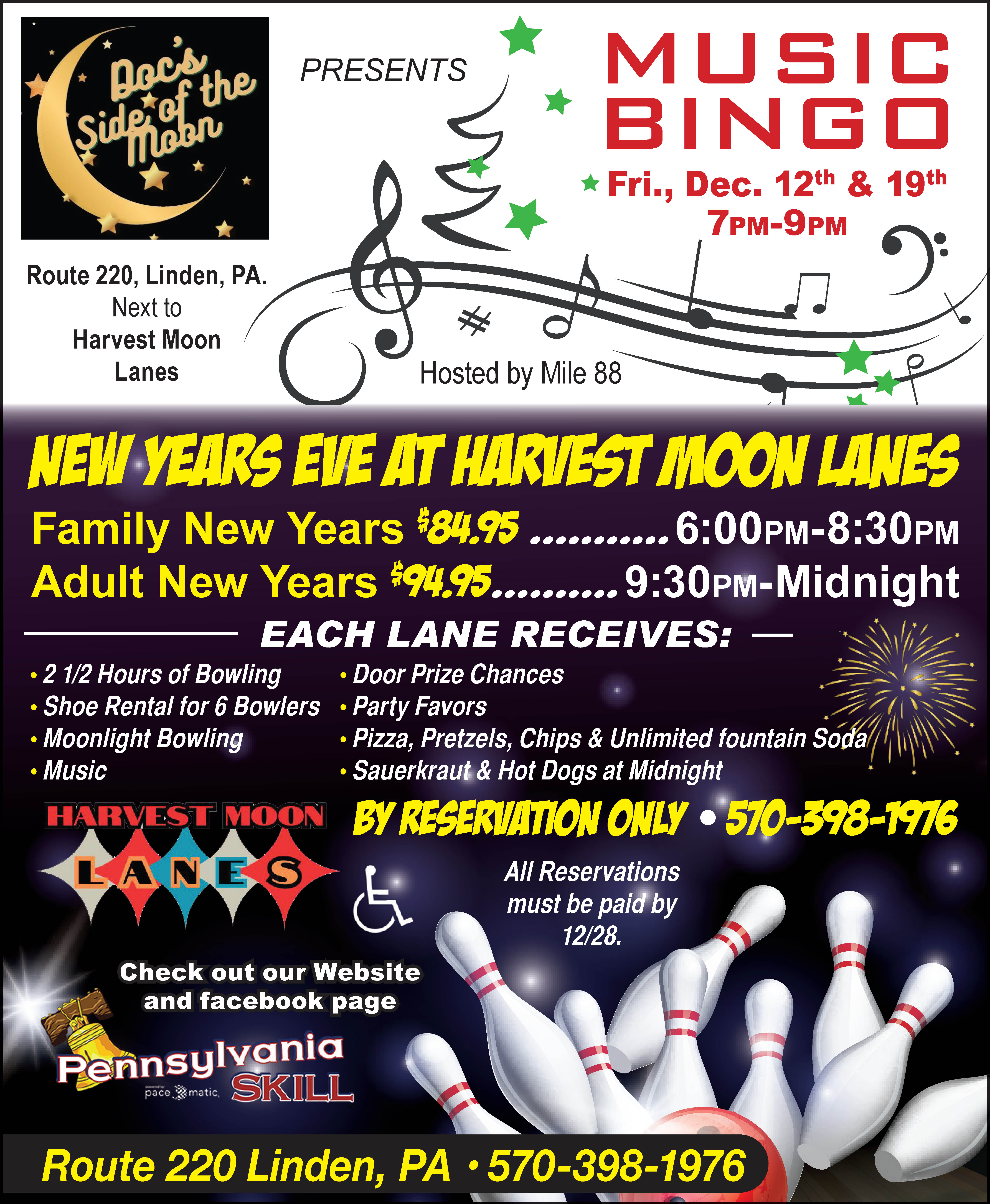The month of February is Black History Month. It celebrates all African Americans’ history, struggles, and accomplishments. It is important to shine a light on some of the significant and notable things about African Americans and their important and interesting role in Lycoming County’s history.
No one knows for sure when the first African Americans made their first appearance in Lycoming County. It is highly possible that some of them were runaway slaves or free persons of color looking for a better life. They perhaps toiled in farming, or labored on the local canal or in the fledgling lumber industry.
The Lycoming County area played a significant role in the Underground Railroad, the courageous group of people who helped to smuggle runaway slaves from the slave territories of the South north to Canada.
There were two centers of Underground Railroad activity in Lycoming County: The Muncy-Pennsdale area, whose participants were mostly Quaker, and the area just north of Williamsport, where Daniel Hughes lived, now known as Freedom Road.
Hughes was part black, part Mohawk, born in New York State in 1812. He was a man of towering stature at over 6 feet 7 inches and weighed about 300 pounds. He moved to this area in 1828 and married Annie Rotch.
Hughes was a lumber river raftsman operating on the Susquehanna River between Williamsport and the area near Baltimore, Maryland. This occupation enabled him to smuggle escaped slaves to the Williamsport area, where he hid the fugitive slaves at his house.
It was a great act of courage for Hughes to spirit these runaways to freedom. His wife and their 16 children were exposed to great danger in the process. It was against the law to assist slaves, punishable by imprisonment and large fines. Also, not everyone in the area was sympathetic to these runaway slaves’ plight, and those who aided them were subject to harassment and sometimes outright physical violence.
Hughes often operated on moonless nights to lessen the chance of detection. He and his son, Robert, conducted slaves to the next “station” near Trout Run, and the runaways would continue their trek to Canada.
After the Civil War, the Hughes family donated a portion of their property along Freedom Road as a cemetery for African Americans. Among those buried, there are nine African American veterans of the Civil War.
Hughes’ story was memorialized for future generations through his great-granddaughter’s efforts, the late Mamie Sweeting Diggs, who made many public presentations about the exploits of her courageous great-grandfather. She was recognized for her dedicated work and research by having an honorary doctorate degree conferred on her by Lycoming College.
One of the most famous Underground Railroad stations in Lycoming County was in Pennsdale, known as the “House of Many Stairs.” At the time of its service on the Underground Railroad, it was the Bulls Head Tavern, owned by Edward Morris. It served as a stagecoach stop that helped to mask its activities as a sanctuary for runaway slaves.
Another Pennsdale sanctuary for escaped slaves was Wolf Run House, owned by a Quaker named William Haines.
The McCarty-Wertman House on Main Street in Muncy also served as a refuge for escaping slaves.
The Quaker Meeting House in Pennsdale also served as a refuge for runaway slaves.
Another Quaker who lived in the Williamsport area was Derrick Updegraff. He offered sanctuary at the Long Reach Plantation along South Reach Road. It later became the Thomas Lightfoot Inn before that structure was torn down in the first decade of the 21st century.
Local African Americans also distinguished themselves in the area of writing and literature. Williamsport native Julia C. Collins is reportedly the first black woman to write a novel in the United States, titled The Curse of Caste, published in 1865.
Her grandson, Frank “Fay” Young, became the first full-time African American sportswriter when he did so in the 1930s for the Chicago Defender. He was a tireless promoter of great black athletes such as Jesse Owens and Joe Louis. He also campaigned zealously for the integration of Major League Baseball and was a confidant of Negro National League founder Andrew “Rube” Foster.
One of the greatest figures in African American history, Frederick Douglass, a former slave who became a friend of Presidents and a spokesman for the aspirations of this people, spoke to an audience in Williamsport on the nights of November 14 and 15, 1867, at Doebler’s Hall, which was located at the northeast corner of Pine and West Fourth streets.
In his first speech, he detailed a “simple plan for the elevation of the Negro.” To whites in the audience, he asked, “that blacks be left alone to forge their own position in society, that they be given a fair chance.” Douglas implored, “If you see him going to school, let him alone. If you see him going into a mechanic’s shop to learn a trade, let him alone. If you see him going to the ballot box, let him alone. Give him a chance to work out his own position.”
To blacks, he urged, “steady, persevering work is the only road to greatness. Nature does the most for those that use the best means.”
In his speech the second night, he chided the federal government for its failure to enact legislation that would give blacks the right to vote. He advocated women’s suffrage more than a half-century before it became the law of the land.
He said, “A man’s rights rest in three boxes: the ballot box, the jury box, and the cartridge box. Let no man be kept from the ballot box because of his color. Let no woman be kept from the ballot box because of her sex.”
Douglass and all African Americans got their wish three years later when the 15th Amendment was ratified, giving blacks the right to vote. To observe this momentous occasion, blacks across Pennsylvania organized celebrations marking the milestone on April 26, 1870.
The Gazette and Bulletin wrote in its April 27, 1870, issue of the local celebration. “Never before yesterday was such a sight as the demonstration of enfranchised colored citizens in the city of Williamsport. Never before yesterday did a body of colored voters assemble together in a deliberative assembly in this city.”
In Williamsport, hundreds of people lined city streets, 42 carriages, and buggies paraded, and people carrying banners, some read “Equal Rights,” and “Free Suffrage.”
African Americans played a role in philanthropic affairs locally as well. Perhaps none is so more well known as a woman who was born into slavery named Mary Slaughter.
She was born on the Myers plantation near Martinsburg, West Virginia, in 1835. She would eventually become the Myers’ favorite cook and housekeeper.
She probably married her husband, William Slaughter, while living on the Myers plantation.
After the Civil War in 1866, she and William moved to Williamsport. They served as custodians at the former St. Paul’s Lutheran Church. She was active at both the First Baptist and Bethel A.M.E. churches.
Tragedy stalked Slaughter. She lost three children at an early age, and her husband died of tuberculosis in 1886.
She needed a constructive outlet to deal with her grief, so she became involved in bettering the lot of elderly black women.
She began initially by providing meals to sick mothers. She opened her four-room house on Walnut Street to elderly black women, and by 1897, it had evolved into the Aged Colored Women’s Home — a place for indigent, elderly African American women. She moved the facility to 124 Brandon Avenue, where it operated until 1973, some 39 years after her death at 99 in 1934.
Percy David (P.D.) Mitchell served as an inspiration to the black community and the community at large for almost 40 years.
He was born in Portsmouth, Virginia, and came to Williamsport in 1943 to act as executive director of the Bethune-Douglass Community Center.
He had a keen interest in sports and was a key figure in organizing and coaching many of the sports teams at Bethune-Douglas. He was also an avid and accomplished bowler who also coached the first men’s and women’s bowling teams in the country to be recognized by the American Bowling Congress.
He was a towering figure in local civic affairs whose counsel was sought by both political and business leaders in the area. His involvement in the Kiwanis Club was one of his most notable activities. He was proud to have been elected the first African American state governor of the Kiwanis Club. He received The Grit’s Meritorious Service Award in 1976. He is one of the most respected figures of any color in the history of Lycoming County. He died in 1981.
In the education field, one woman teacher, Miss Lila Mae Fisher, stands as a trailblazer in teaching locally for African Americans. The information on Fisher was obtained from an article on Williamsport Women by Mary Sieminski.
“Miss Lila,” as she was affectionately known, taught in local schools from 1909 to 1949. She taught at a time when the Williamsport schools were virtually segregated. She taught at the Emery School, which in 1938 became the former Bethune-Douglass Center, and she later taught at Transeau School. She enjoyed an excellent reputation and was remembered fondly by her former students.
Williamsport’s African Americans were always there when they were called to their country’s colors. Perhaps the most distinguished local black military figure was Navy Captain Chancellor “Pete” Tzomes, who was the first African American to command a U.S. Navy nuclear submarine.
Tzomes described growing up in Williamsport to me in a June 2014 Webb Weekly article. He recalled that there were just two neighborhoods that Williamsport’s blacks were concentrated in. Realtors and property owners would not sell to blacks outside of those two neighborhoods.
“I remember very well when P.D. Mitchell only wanted to move two blocks from where he lived on Park Avenue up to High Street. It caused a great uproar,” Tzomes said. “Mr. Mitchell got death threats and rocks and bricks thrown through his windows.”
Accommodations were segregated in Williamsport at the time. No hotel would take blacks in. As a result, Tzomes’ mother and a woman across the street, Mrs. Mellix, opened up tourist homes at their house for blacks who came to town to stay. When the famous jazz singing group the “Ink Spots” came to town, the Lycoming Hotel, now the Genetti, would not allow them to stay there, so they stayed at the two tourist homes.
“The schools were not segregated, and you interacted and played with white kids,” Tzomes said. “But many times, when the parents of some of these children heard they were playing with you and hanging out with you, they told their children that they did not want their kids playing with you anymore because you were black.”
Tzomes graduated from the U.S. Naval Academy in 1967 and went on to a distinguished naval career. He died in 2020.
Many distinguished African Americans have appeared in Lycoming County as speakers or performers.
In the social activist realm, foremost of these was Dr. Martin Luther King Jr., who spoke at Lycoming College in April 1958. He spoke about the successful Montgomery Bus Boycott.
Mary McLeod Bethune, a crusader for equal rights and a great friend to Eleanor Roosevelt, spoke here in the 1940s.
Dr. Ralph Bunche, former high U.N. official and winner of the Nobel Peace Prize, spoke here during the 1970s.
The first African American elected President of the United States, Barack Obama, campaigned at Lycoming College in 2008 during a hard-fought primary fight with Hillary Clinton in Pennsylvania. Jesse Jackson also campaigned here in 1984 during his 1984 bid for the Democratic Presidential nomination.
In the performing arts, legendary jazz singer Ella Fitzgerald performed locally with the Chick Webb Band in 1937.
The great Louis “Satchmo” Armstrong performed here in 1957, and Duke Ellington and his band played here during the 1960s.
The Duke Ellington Orchestra appeared locally during the 1950s.
Ray Charles appeared twice during the 1990s. Motown great Smokey Robinson performed here in the early 2000s.
In sports, some of the best talents of the Negro Leagues saw action locally at Bowman Field, including Oscar Charleston, Buck Leonard, Satchel Paige, Josh Gibson, Leon Day, and Rube Foster, just to name a few.
The man many baseball historians regard as the greatest black pitcher of the 19th Century, George Stovey, came from Williamsport and is buried in Wildwood Cemetery.
Wilt Chamberlin played here with the Harlem Globetrotters in the late 1950s.
1936 Olympic track gold medalist Jesse Owens spoke here in 1972.
The always-colorful Muhammad Ali appeared at a boxing show at the old West Third Street Gym in February 1972.
Former Heavyweight Champion Jersey Joe Walcott spoke here in the early 1970s.
In recent years, African Americans have continued breaking down barriers and recording milestones. In 2020, Derek Slaughter became the first African American Mayor of Williamsport. And just this year, Patrick Wilson became the first African American President and CEO of Little League International Inc.
I was reminded of the dignity and strength of the African American community last week when I attended the funeral of Barbara Moore Allen, a beloved and active member of the local African American community.
I am sure I may have missed some distinguished persons or persons who might have appeared over the years, but I hope this gives you some flavor of the caliber of people who have come here over the years.
I also hope that I have been able to show how deeply ingrained African Americans have been into the social, civic, and historical fiber of Lycoming County over the years. If any of you have any information about any additional information about local African American history, please let us know.



